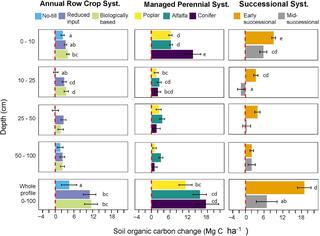Long-term study quantifies management impacts on soil carbon stores

Courtesy of authors
Background/Objective
- Soil organic carbon (SOC) is critical to bioenergy cropping system success and strongly affected by land management practices, yet few long-term studies have examined change throughout the soil profile or across alternative cropping systems.
Approach
- Researchers quantified 25-year SOC changes to 1 m depth in 10 replicate ecosystems at an experimental site in the Upper Midwest: four annual row crop systems with conventional, no-till, reduced input, and biological management, two with cover crops; three managed perennial systems (alfalfa, conifer, and poplar); and three successional systems (early, mid-, and late-successional forest). Researchers analyzed soil core samples taken in 2001, 2013, and 2022 to quantify carbon and nitrogen levels in each system.
Results
- Organic carbon and nitrogen were stable across the 25 year sampling period in conventional and late-successional systems. Other systems gained SOC in the order: early successional > alfalfa and conifer > poplar, reduced input, and biological > mid-successional and no-till. In almost all cases rates of accretion slowed from the first 12 years of alternative management. Diverse perennial plantings, including those harvested annually for biofuel, demonstrated the fastest rates of SOC accumulation.
Impact
- Soil organic matter is critical for soil health and resilience, yet conventional cropping systems in the U.S. Midwest have lost 40-60% of initial levels. Results underscore the importance of cover crops, perennial crops, and no-till options for sequestering whole profile C in intensively farmed croplands whether managed for cellulosic bioenergy or grain. Cover cropped and perennial systems are particularly relevant to bioenergy cropping.
Citation
- Córdova, S. C., Kravchenko, A. N., Miesel, J. R., & Robertson, G. P. Soil carbon change in intensive agriculture after 25 years of conservation management. Geoderma, 453, 117133. (2025). [DOI:10.1016/j.geoderma.2024.117133]
Sustainable Bioenergy Cropping Systems